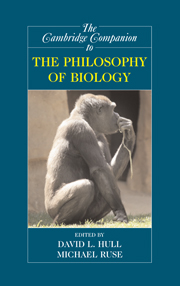Book contents
- Frontmatter
- 1 Adaptation
- 2 Population Genetics
- 3 Units and Levels of Selection
- 4 What’s Wrong with the Emergentist Statistical Interpretation of Natural Selection and Random Drift?
- 5 Gene
- 6 Information in Biology
- 7 Reductionism (and Antireductionism) in Biology
- 8 Mechanisms and Models
- 9 Teleology
- 10 Macroevolution, Minimalism, and the Radiation of the Animals
- 11 Philosophy and Phylogenetics: Historical and Current Connections
- 12 Human Evolution: The Three Grand Challenges of Human Biology
- 13 Varieties of Evolutionary Psychology
- 14 Neurobiology
- 15 Biological Explanations of Human Sexuality: The Genetic Basis of Sexual Orientation
- 16 Game Theory in Evolutionary Biology
- 17 What Is an ‘Embryo’ and How Do We Know?
- 18 Evolutionary Developmental Biology
- 19 Molecular and Systems Biology and Bioethics
- 20 Ecology
- 21 From Ecological Diversity to Biodiversity
- 22 Biology and Religion
- 23 The Moral Grammar of Narratives in History of Biology: The Case of Haeckel and Nazi Biology
- Reference List
- Index
- Series List
6 - Information in Biology
Published online by Cambridge University Press: 28 April 2008
- Frontmatter
- 1 Adaptation
- 2 Population Genetics
- 3 Units and Levels of Selection
- 4 What’s Wrong with the Emergentist Statistical Interpretation of Natural Selection and Random Drift?
- 5 Gene
- 6 Information in Biology
- 7 Reductionism (and Antireductionism) in Biology
- 8 Mechanisms and Models
- 9 Teleology
- 10 Macroevolution, Minimalism, and the Radiation of the Animals
- 11 Philosophy and Phylogenetics: Historical and Current Connections
- 12 Human Evolution: The Three Grand Challenges of Human Biology
- 13 Varieties of Evolutionary Psychology
- 14 Neurobiology
- 15 Biological Explanations of Human Sexuality: The Genetic Basis of Sexual Orientation
- 16 Game Theory in Evolutionary Biology
- 17 What Is an ‘Embryo’ and How Do We Know?
- 18 Evolutionary Developmental Biology
- 19 Molecular and Systems Biology and Bioethics
- 20 Ecology
- 21 From Ecological Diversity to Biodiversity
- 22 Biology and Religion
- 23 The Moral Grammar of Narratives in History of Biology: The Case of Haeckel and Nazi Biology
- Reference List
- Index
- Series List
Summary
INTRODUCTION
The concept of information has acquired a strikingly prominent role in contemporary biology. This trend is especially marked within genetics, but it has also become important in other areas, such as evolutionary theory and developmental biology, especially where these fields border on genetics. The most distinctive biological role for informational concepts, and the one that has generated the most discussion, is in the description of the relations between genes and the various structures and processes that genes play a role in causing. For many biologists, the causal role of genes should be understood in terms of their carrying information about their various products. That information might require the cooperation of various environmental factors before it can be “expressed,” but the same can be said of other kinds of message.
An initial response might be to think that this mode of description is entirely anchored in a set of well-established facts about the role of DNA and RNA within protein synthesis, summarized in the familiar chart representing the “genetic code,” mapping DNA base triplets to amino acids. However, informational enthusiasm in biology predates even a rudimentary understanding of these mechanisms (Schrodinger 1944). And more importantly, current applications of informational concepts extend far beyond anything that can receive an obvious justification in terms of the familiar facts about the specification of protein molecules by DNA.
- Type
- Chapter
- Information
- The Cambridge Companion to the Philosophy of Biology , pp. 103 - 119Publisher: Cambridge University PressPrint publication year: 2007
- 37
- Cited by



